Agrivoltaics: A Digital Twin to Learn the Effect of Solar Panel Coverage on Crop Growth †
Abstract
1. Introduction
2. Methods
2.1. Experimental Equipment
- Soil temperature and moisture sensors: multiple probes (5TM Meter) were installed to measure soil temperatures and moisture at various locations at 10 cm within the lysimeter;
- Light sensors: an Arduino-based light sensors were placed at various positions across the lysimeter to measure light intensity and distribution;
- Radiation Sensor: a radiometer (CNR 1 by Kipp and Zonen) was mounted to measure incoming and outgoing shortwave and longwave radiation, providing data on the energy balance within the system;
- Air temperature and air humidity sensor: a thermohydrometer from Vaisala was installed to monitor the relative air humidity and air temperature above the crop canopy.
- Lighting System: Four 400 W halogen lamps provided the primary light source, simulating sunlight and one 300 W infrared/ultraviolet lamp supplied supplementary radiation, ensuring spectral comprehensiveness. Light is provided only at nadir;
- Drip Irrigation System: This allowed precise control of water input, enabling the simulation of precipitation scenarios;
- Data Acquisition System: A central data logger continuously recorded measurements from all sensors at programmable intervals;
- Weighing System: The entire lysimeter was placed on a large scale to monitor overall mass changes, providing data on evapotranspiration and water balance.
2.2. Crop Selection
2.3. Experimental Setup
- Effective planting area: 1.2 m × 1.2 m;
- Panel arrangement: The effective area was divided into three equal rows of 0.4 m in width and 1.2 m in length each;
- Shading structure: Panels were installed over the two lateral rows, leaving one row in the middle unshaded;
- Panel composition: Each row consisted of 6 individual panels, each measuring 20 cm × 40 cm;
- Panel height: The panels were elevated 30 cm above the crop surface;
- Unshaded area: One row (0.4 m × 1.2 m) remained completely unshaded, creating a mixed light environment within the lysimeter.
- Effective planting area: 1.2 m × 1.2 m;
- Panel arrangement: The effective area was divided into three equal rows of 0.4 m in width and 1.2 m in length each;
- Shading structure: Panels were installed over the two lateral rows, but with gaps between panels, leaving one row in the middle completely unshaded;
- Panel composition: Each row consisted of 3 individual panels, each measuring 20 cm × 40 cm, with 20 cm gaps between panels;
- Panel height: The panels were elevated 30 cm above the crop surface;
- Unshaded area: One row (0.4 m × 1.2 m) remained completely unshaded, creating a mixed light environment within the lysimeter.
3. Results and Discussion
3.1. Experiment Results
3.1.1. Air Temperature
3.1.2. Light Levels
3.1.3. Radiation
3.1.4. Soil Moisture
- In Experiment 2, Probe 1 (under panel) consistently shows higher soil moisture levels (ranging from about 0.25 to 0.31) compared to Probe 2 (exposed, ranging from about 0.15 to 0.25). This suggests that the panels effectively reduce evaporation, leading to higher soil moisture retention underneath;
- Experiment 3 displays a similar trend, with Probe 1 (under panel) maintaining higher soil moisture levels compared to Probe 2 (exposed). However, the difference between the two probes appears less pronounced than in Experiment 2, possibly due to the intermittent panel arrangement allowing lighter and air circulation.
3.1.5. Soil Temperature
3.1.6. Yield
3.2. Discussion
4. Conclusions
Author Contributions
Funding
Institutional Review Board Statement
Informed Consent Statement
Data Availability Statement
Acknowledgments
Conflicts of Interest
References
- Dupraz, C.; Marrou, H.; Talbot, G.; Dufour, L.; Nogier, A.; Ferard, Y. Combining solar photovoltaic panels and food crops for optimising land use: Towards new agrivoltaic schemes. Renew. Energy 2011, 36, 2725–2732. [Google Scholar] [CrossRef]
- Weselek, A.; Ehmann, A.; Zikeli, S.; Lewandowski, I.; Schindele, S.; Högy, P. Agrophotovoltaic systems: Applications, challenges, and opportunities. A review. Agron. Sustain. Dev. 2019, 39, 35. [Google Scholar] [CrossRef]
- Barron-Gafford, G.A.; Pavao-Zuckerman, M.A.; Minor, R.L.; Sutter, L.F.; Barnett-Moreno, I.; Blackett, D.T.; Thompson, M.; Dimond, K.; Gerlak, A.K.; Nabhan, G.P.; et al. Agrivoltaics provide mutual benefits across the food–energy–water nexus in drylands. Nat. Sustain. 2019, 2, 848–855. [Google Scholar] [CrossRef]
- Marrou, H.; Wery, J.; Dufour, L.; Dupraz, C. Productivity and radiation use efficiency of lettuces grown in the partial shade of photovoltaic panels. Eur. J. Agron. 2013, 44, 54–66. [Google Scholar] [CrossRef]
- Adeh, E.H.; Good, S.P.; Calaf, M.; Higgins, C.W. Solar PV power potential is greatest over croplands. Sci. Rep. 2019, 9, 11442. [Google Scholar] [CrossRef] [PubMed]
- Campana, P.E.; Stridh, B.; Amaducci, S.; Colauzzi, M. Optimisation of agrivoltaic systems: Synergies for rural communities’ resilience in the food-water-energy nexus. Renew. Sustain. Energy Rev. 2021, 150, 111452. [Google Scholar]
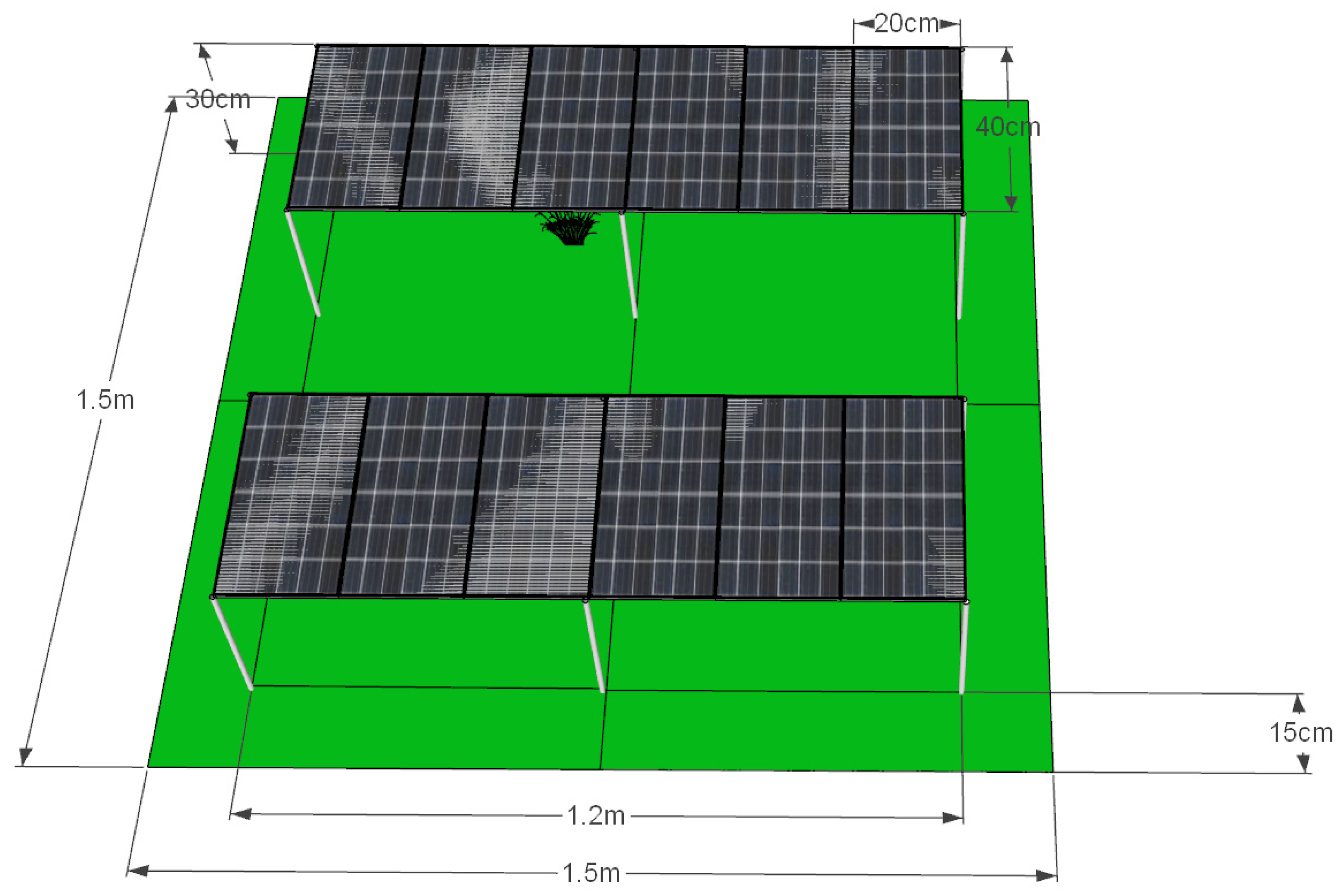
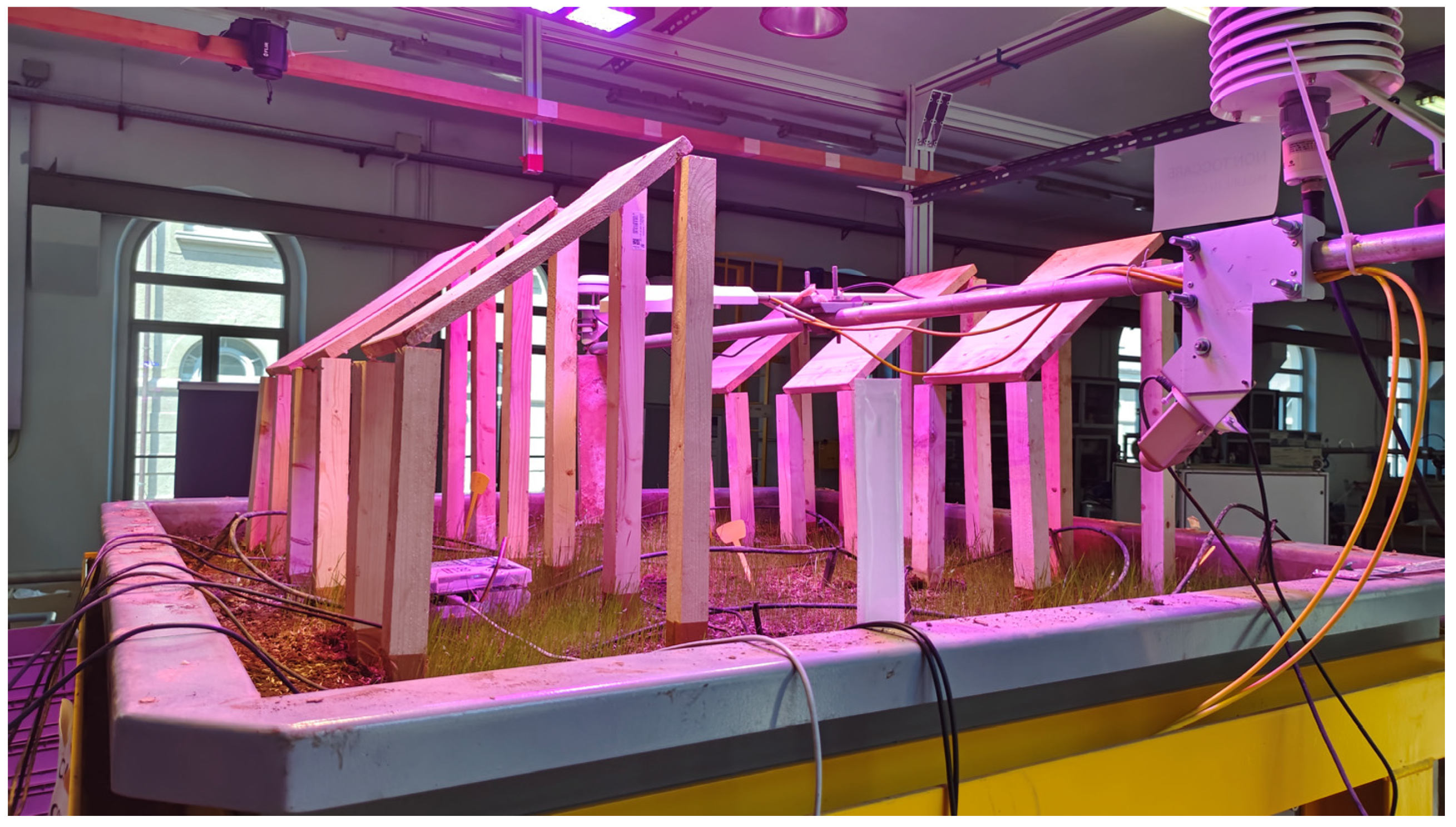


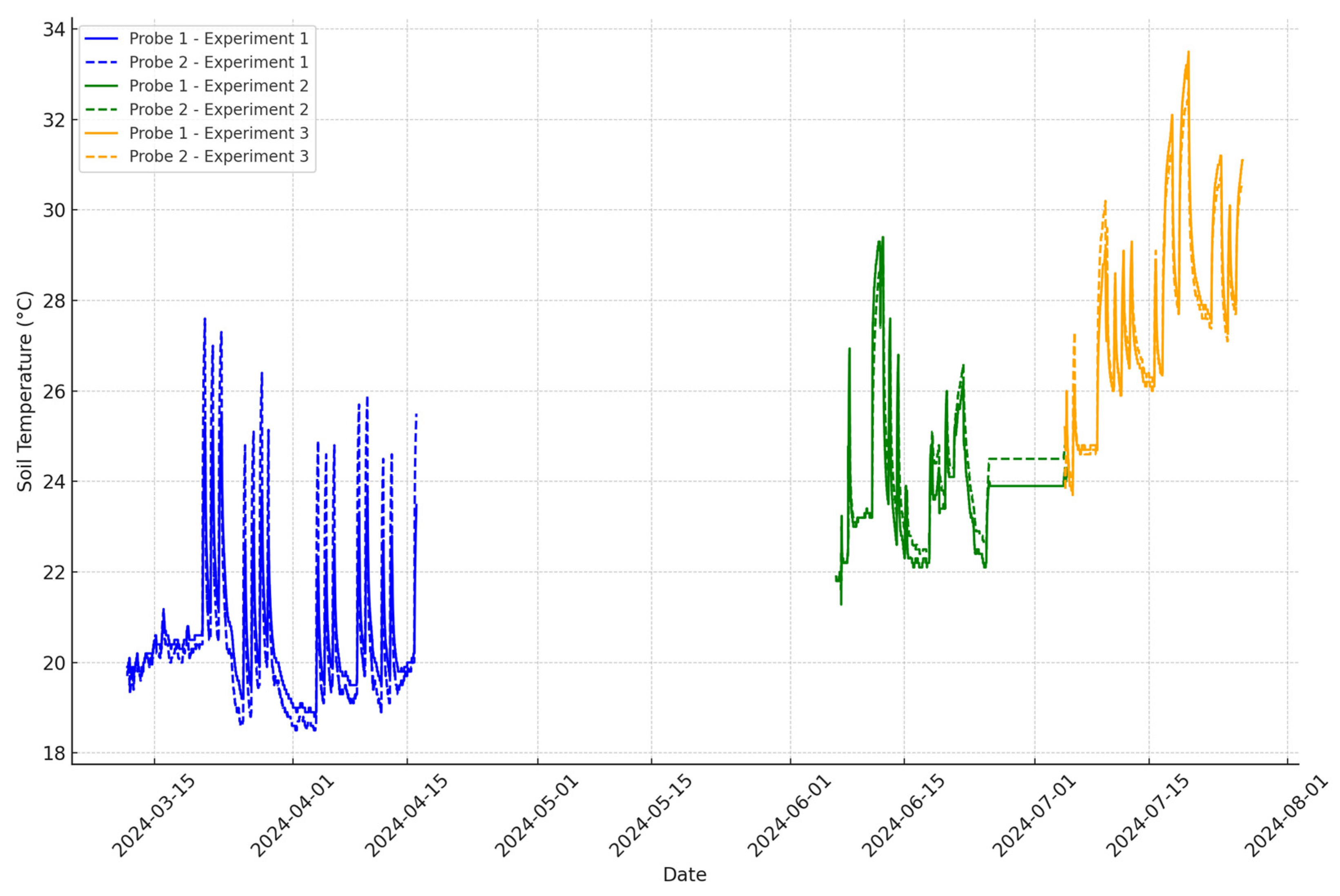
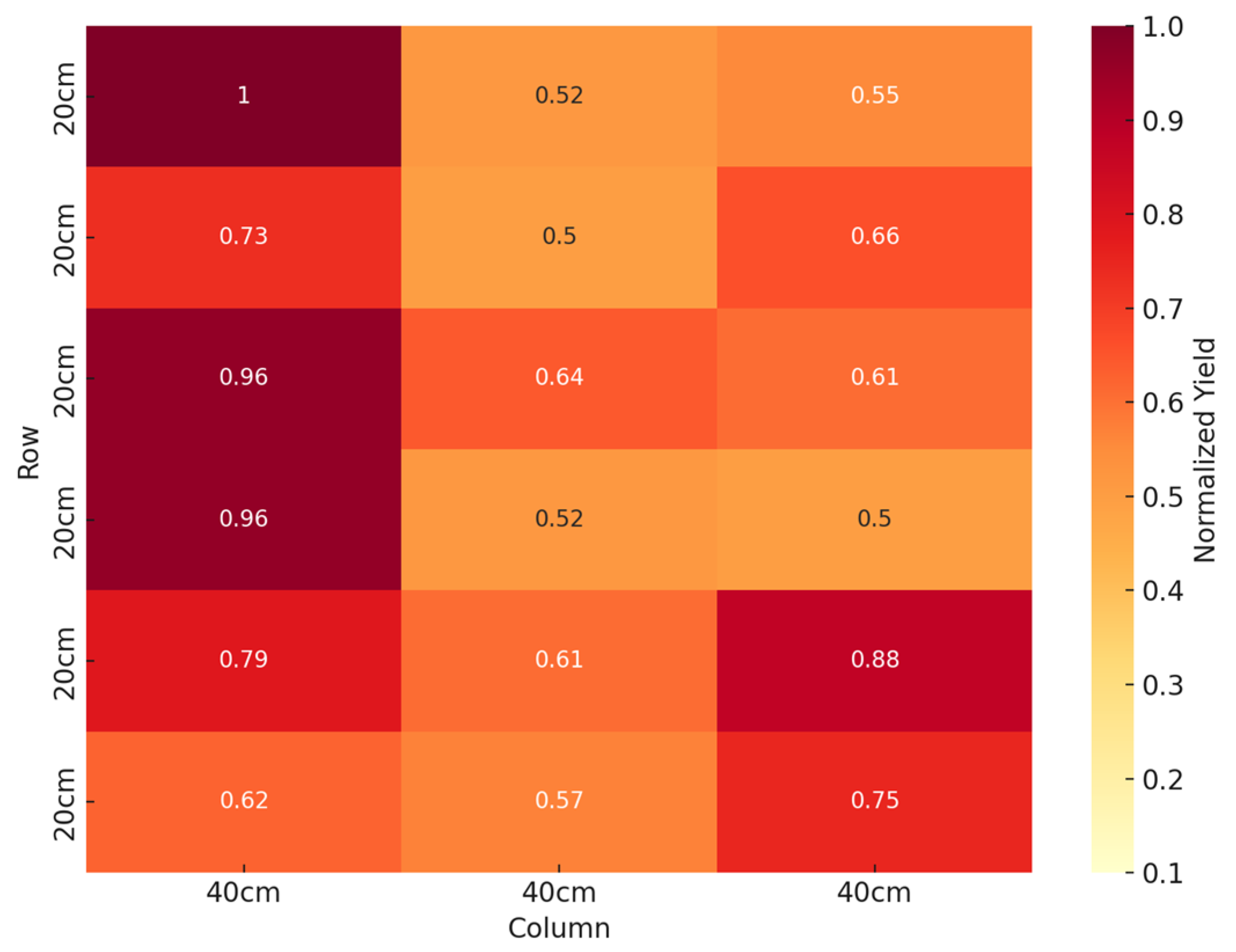
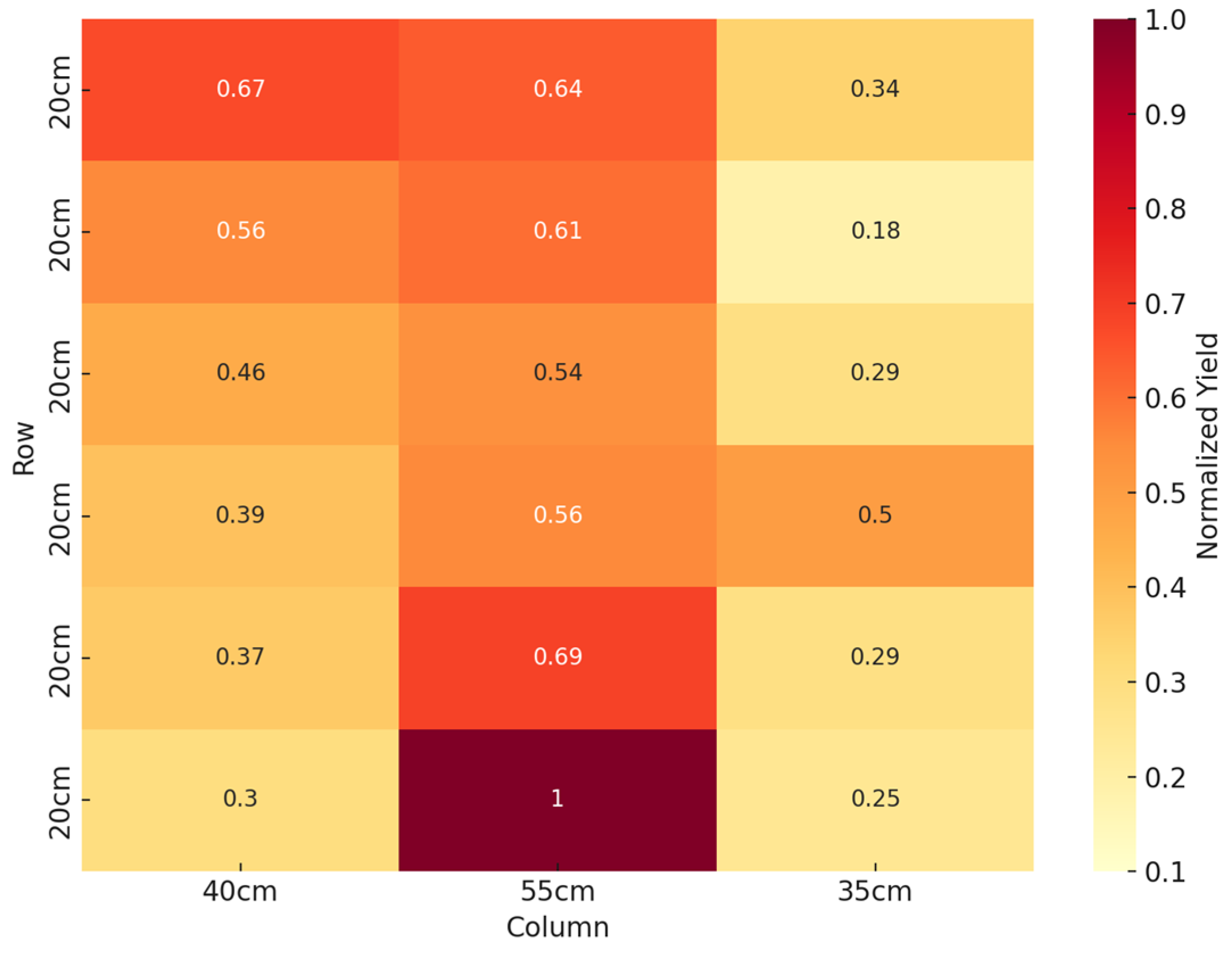

| Experiment Comparison Statistics | Experiment Mean ± SD |
|---|---|
| Experiment 1 | 20.39 ± 1.04 |
| Experiment 2 | 24.57 ± 1.22 |
| Experiment 3 | 28.16 ± 1.47 |
| Experiment | Incoming Shortwave Radiation Average (Mean ± SD) |
|---|---|
| Experiment 1 | 30.37 ± 85.55 |
| Experiment 2 | 112.32 ± 163.62 |
| Experiment 3 | 119.20 ± 154.03 |
Disclaimer/Publisher’s Note: The statements, opinions and data contained in all publications are solely those of the individual author(s) and contributor(s) and not of MDPI and/or the editor(s). MDPI and/or the editor(s) disclaim responsibility for any injury to people or property resulting from any ideas, methods, instructions or products referred to in the content. |
© 2024 by the authors. Licensee MDPI, Basel, Switzerland. This article is an open access article distributed under the terms and conditions of the Creative Commons Attribution (CC BY) license (https://creativecommons.org/licenses/by/4.0/).
Share and Cite
Chen, J.; Paciolla, N.; Mariani, S.; Corbari, C. Agrivoltaics: A Digital Twin to Learn the Effect of Solar Panel Coverage on Crop Growth. Eng. Proc. 2024, 82, 5. https://doi.org/10.3390/ecsa-11-20486
Chen J, Paciolla N, Mariani S, Corbari C. Agrivoltaics: A Digital Twin to Learn the Effect of Solar Panel Coverage on Crop Growth. Engineering Proceedings. 2024; 82(1):5. https://doi.org/10.3390/ecsa-11-20486
Chicago/Turabian StyleChen, Jiawei, Nicola Paciolla, Stefano Mariani, and Chiara Corbari. 2024. "Agrivoltaics: A Digital Twin to Learn the Effect of Solar Panel Coverage on Crop Growth" Engineering Proceedings 82, no. 1: 5. https://doi.org/10.3390/ecsa-11-20486
APA StyleChen, J., Paciolla, N., Mariani, S., & Corbari, C. (2024). Agrivoltaics: A Digital Twin to Learn the Effect of Solar Panel Coverage on Crop Growth. Engineering Proceedings, 82(1), 5. https://doi.org/10.3390/ecsa-11-20486








